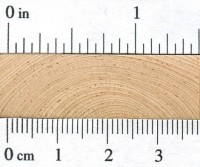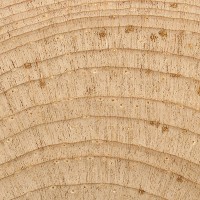 |
Common Name(s): Limber Pine, Rocky Mountain White Pine Scientific Name: Pinus flexilis Distribution: Mountainous regions of western North America Tree Size: 40-50 ft (12-15 m) tall, 2-3 ft (.6-1 m) trunk diameter Average Dried Weight: 28 lbs/ft3 (450 kg/m3) Specific Gravity (Basic, 12% MC): .37, .45 Janka Hardness: 430 lbf (1,910 N) Modulus of Rupture: 9,100 lbf/in2 (62.8 MPa) Elastic Modulus: 1,170,000 lbf/in2 (8.07 GPa) Crushing Strength: 5,290 lbf/in2 (36.5 MPa) Shrinkage: Radial: 2.4%, Tangential: 5.1%, Volumetric: 8.2%, T/R Ratio: 2.1 |
Color/Appearance: Heartwood is a light brown, sometimes with a slightly reddish hue, narrow sapwood is a pale yellow to nearly white. Color tends to darken with age.
Grain/Texture: Grain is straight with an even, medium texture.
Endgrain: Large resin canals, numerous and evenly distributed, mostly solitary; earlywood to latewood transition somewhat gradual, color contrast low; tracheid diameter medium to large.
Rot Resistance: The heartwood is rated as moderate to low in decay resistance.
Workability: Limber Pine is easy to work with both hand and machine tools. Glues and finishes well.
Odor: Limber Pine has a faint, resinous odor while being worked.
Allergies/Toxicity: Working with pine has been reported to cause allergic skin reactions and/or asthma-like symptoms in some people. See the articles Wood Allergies and Toxicity and Wood Dust Safety for more information.
Pricing/Availability: Because the trees are small, slow-growing, and with an irregular growth form, there is virtually no commercial value for Limber Pine lumber. The tree is sometimes harvested incidentally along with other, more commercially valuable species.
Sustainability: This wood species is not listed in the CITES Appendices, and is reported by the IUCN as being a species of least concern.
Common Uses: Fuelwood, boxes, and rough construction.
Comments: Limber Pine is a member of the White Pine group, which includes primary timber producers such as: Sugar Pine, Western White Pine, and Eastern White Pine. But unlike it’s close relatives, Limber Pine has very little commercial value, and isn’t commonly used for lumber.
- Austrian Pine (Pinus nigra)
- Caribbean Pine (Pinus caribaea)
- Eastern White Pine (Pinus strobus)
- Jack Pine (Pinus banksiana)
- Jeffrey Pine (Pinus jeffreyi)
- Khasi Pine (Pinus kesiya)
- Loblolly Pine (Pinus taeda)
- Lodgepole Pine (Pinus contorta)
- Longleaf Pine (Pinus palustris)
- Maritime Pine (Pinus pinaster)
- Ocote Pine (Pinus oocarpa)
- Patula Pine (Pinus patula)
- Pinyon Pine (Pinus edulis)
- Pitch Pine (Pinus rigida)
- Pond Pine (Pinus serotina)
- Ponderosa Pine (Pinus ponderosa)
- Radiata Pine (Pinus radiata)
- Red Pine (Pinus resinosa)
- Sand Pine (Pinus clausa)
- Scots Pine (Pinus sylvestris)
- Shortleaf Pine (Pinus echinata)
- Slash Pine (Pinus elliottii)
- Spruce Pine (Pinus glabra)
- Sugar Pine (Pinus lambertiana)
- Sumatran Pine (Pinus merkusii)
- Table Mountain Pine (Pinus pungens)
- Western White Pine (Pinus monticola)
- Virginia Pine (Pinus virginiana)







